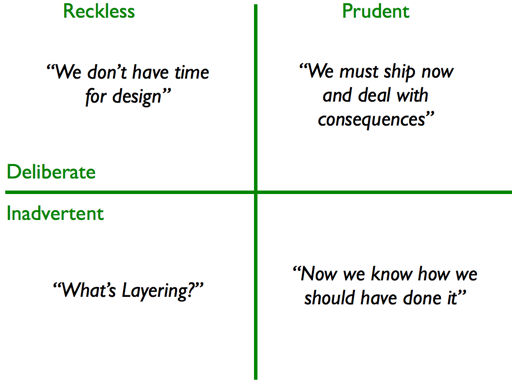Software Development Technical Debt Technology
Technical Debt as Metaphor, Where it Works and Where it Doesn't
I am across this article doing research for another post, I really enjoyed and think it is extremely valuable way to think about technical debt.
https://martinfowler.com/bliki/TechnicalDebtQuadrant.html
I'd go so far as to say, I'm going to expect developers I work with to read it and tell me which kind of technical debt they're talking about.
You should take the time to read the whole article. It's great. I'm not going to summarize it, only talk about a couple of things that I think are valuable and interesting.
Here's the quadrants for technical debt as Fowler defines them:

The first part of the article discusses the concept of technical debt and how it works as a metaphor to financial debt. Largely this distinguishes the concept of prudent from reckless debt, which is a useful distinction to have on hand for discussing projects with developers and clients.
In the financial realm you have prudent debts that you take on carefully, after doing your research, in order to further your goals. Buying a home, buying a car, purchasing rental property.
And then you have reckless debt that is taken on without proper research or out of alignment with your goals like buying a luxury items you can't afford.
There are two parts of this that I want to talk about in a bit more depth.
The first piece has to do with the concept of prudent, deliberate debt and where we begin taking it on in a project. I've had many conversations with developers over the years who may struggle to shift their mindset as you reach the end stages of a project.
Developers like to do things the right way - the scalable way, the smart way, the most effective way. I certainly did when I was a developer, and all the good developers I've known share this characteristic.
But there are times when you just need to finish off a feature or two and launch a product. Delays are dangerous in this situation. This is the moment to switch from avoiding all debt to taking on prudent, deliberate debt. It's time to say, "Yes, we could design it that way, but we need these features and we need to go to QA next week so please get it done."
Business realities drive us to these decisions, and most importantly, it is not wrong to do this. If you were a very savvy PM or product owner you might even put a date on the calendar when you think the decision making may change.
This doesn't negate the value of the all the design and hard work that went before it, nor does it mean you can't go back and revisit these items in the future. It just means, right now, in this phase of the project, we are making pragmatic decisions to ship and that is 100% OK and in line with best practices.
The second is the concept of prudent, inadvertent debt. Every project has it. No good developers are ever really satisfied as a result of it. But we can't ever truly get rid of it.
Why is that?
Just for clarification: prudent, inadvertent technical debt is the idea that some parts of system design will only really be apparent after the project is complete or once a particular phase is too far along to alter them.
This concept has no analog in the financial debt metaphor. There isn't a financial debt you can take on inadvertently and still be prudent. Being prudent implies that you don't have inadvertent financial debts.
But software is not finance - every software project has things that the development team would like to refactor toward the end.
If every project has this type of technical debt, why can't we eliminate it?
We can't eliminate it for two reasons:
- Technology changes too quickly. New tools come along and those tools have real business value so they can't be ignored. We bring them in to projects knowing we don't have every design ready for them. We do this because we push for ever greater scale, effectiveness, and feature delivery. We do it knowing it results in imperfect designs.
- Business Spaces are too diverse and changing too rapidly. Just when we think we understand an audience or a business, it changes. You can't be complacent, you can't rest thinking you know everything, you don't. Neither can you be paralyzed by such knowledge.
So, when you mix 1 and 2 together you get a situation where you can't design everything in advance. You look at the past, look at what you've done wrong and right, look at what you know about the tools you're using. And then you take the leap. You know you will taken on prudent, inadvertent debt by doing so.
The best bosses and clients understand this. It's why we like working for them and why work hard to eliminate everything else and build the great products we're capable of building.

Jonathan Fries
I work for Techtonic as the leader of the software delivery group. I am a Certified Scrum Product Owner.